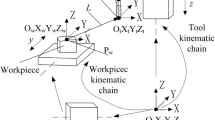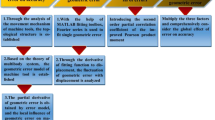Abstract
HSK shank is the most widely used shank in high speed machining recently, the key dimensions’ measurement technology of which decides the level of its manufacture precision. How to accomplish the dimensions’ measurement for HSK shank quickly and accurately is crucial for improving its manufacture level. In order to solve this problem, a kind of special measuring gauge for HSK shank is developed. A novel and simple positioning device is developed according to the idea of limiting shank’s degrees of freedom, which is the most important component and affects measuring precision greatly. It is pointed out that positioning device is a major factor which leads to the generation of system error. By means of theoretical analysis and computing errors derived from various deviation of each transducer relative to its theoretical installing location are studied in detail, by experimental measuring and data computing random errors are analyzed accurately. Error transmission on indirectly measured dimension and measurement standard uncertainty of key dimensions are studied respectively. Research shows that measuring precision of the gauge meets the requirement of high-precision measurement for HSK shank’s key dimensions.













Similar content being viewed by others
References
Yang, Y., Zhang, W.H., Ma, Y.C., Wan, M.: Generalized method for the analysis of bending, torsional and axial receptances of tool-holder-spindle assembly. Int. J. Mach. Tools Manuf. 99, 48–67 (2015)
Gilovoi, L.Ya., Molodtsov, V.V.: Influence of centrifugal forces on the operation of HSK couplings. Russ. Eng. Res. 32(3), 276–281 (2012)
Jie, W.K., Chen, J., Zheng, D.S., Wang, G.C.: The coupling characteristic of HSK tool-holder/spindle interface for high-speed NC machine tool. Appl. Mech. Mater. 590, 121–125 (2014)
Zhang, G., Zhang, Y., Lü, F., Xiu, S.: Analysis on HSK toolholder-spindle interface at high rotational speed for CNC machine tools. China Mech. Eng. 23(6), 631–635 (2012)
Kim, K., Kim, J.: Dynamic displacement measurement of a vibratory object using a terrestrial laser scanner. Meas. Sci. Technol. 26(4), 45002–45012 (2015)
Kondo, Y., Hasegawa, K., Kawamata, H., Morishita, T., Naito, F.: On-machine non-contact dimension-measurement system with laser displacement sensor for vane-tip machining of RFQs. Nucl. Instrum. Methods Phys. Res. 667(5), 5–10 (2012)
Shiramatsu, T., Kitano, K., Kawada, M., Mitsui, K.: Development of measurement method for shape and dimension of micro-components. Jpn. J. Appl. Phys. 51(47), 369–376 (2012)
Kwon, Y., Hong, J.: Integrated remote control of the process capability and the accuracy of vision calibration. Robot. Computer-Integr. Manuf. 30, 451–459 (2014)
Zhao, Z.Y., Zhu, J.G., Xue, B., Yang, L.H.: Optimization for calibration of large-scale optical measurement positioning system by using spherical constraint. J. Opt. Soc. Am. A 31(7), 1427–1435 (2014)
Ibaraki, S., Iritani, T., Matsushita, T.: Calibration of location errors of rotary axes on five-axis machine tools by on-the-machine measurement using a touch-trigger probe. Int. J. Mach. Tools Manuf. 580, 44–53 (2012)
Lee, K., Lee, D.M., Yang, S.H.: Parametric modeling and estimation of geometric errors for a rotary axis using double ball-bar. Int. J. Adv. Manuf. Technol. 62(5), 741–750 (2012)
Yuen, K.V.: Updating large models for mechanical systems using incomplete modal measurement. Mech. Syst. Signal Process. 28(2), 297–308 (2012)
You, H., Yang, J.: Development of an analysis system for geometric contour error evaluation in ultra-precision machining for microlens arrays. J. Mech. Sci. Technol. 28(10), 4121–4129 (2014)
Lee, J.C., Lee, K.I., Yang, S.H.: Development of compact three-degrees-of-freedom compensation system for geometric errors of an ultra-precision linear axis. Mech. Mach. Theory 99, 72–82 (2016)
Yang, Z., Hong, J., Zhang, J.H.: Research on the rotational accuracy measurement of an aerostatic spindle in a rolling bearing performance analysis instrument. Int. J. Precis. Eng. Manuf. 15(7), 1293–1302 (2014)
Ashok, S.D., Samuel, G.L.: Modeling, measurement, and evaluation of spindle radial errors in a miniaturized machine tool. Int. J. Adv. Manuf. Technol. 59(5), 445–461 (2012)
Soori, M., Arezoo, B., Habibi, M.: Dimensional and geometrical errors of three-axis CNC milling machines in a virtual machining system. Computer-Aided Des. 45(11), 1306–1313 (2013)
Anandan, K.P., Tulsian, A.S., Donmez, A., Ozdoganlar, O.B.: A Technique for measuring radial error motions of ultra-high-speed miniature spindles used for micromachining. Precis. Eng. 36(1), 104–120 (2012)
Matekar, S.B., Gogate, G.R.: Optimum synthesis of path generating four-bar mechanisms using differential evolution and a modified error function. Mech. Mach. Theory 52(3), 158–179 (2012)
Gogate, G.R., Matekar, S.B.: Optimum synthesis of motion generating four-bar mechanisms using alternate error functions. Mech. Mach. Theory 54(4), 41–61 (2012)
Luo, X.B., Fan, H.Q., Song, Z.Y., Fu, Q.: Bernoulli particle filter with observer altitude for maritime radiation source tracking in the presence of measurement uncertainty. Chin. J. Aeronaut. 26(6), 1459–1470 (2013)
Aggogeri, F., Barbato, G., Barini, E.M., Genta, G., Levi, R.: Measurement uncertainty assessment of coordinate measuring machines by simulation and planned experimentation. Cirp J. Manuf. Sci. Technol. 4(1), 51–56 (2011)
Koviljka, Stankovi: Influence of the plain-parallel electrode surface dimensions on the type A measurement uncertainty of GM counter. Nucl. Technol. Radiat. Prot. 26(1), 39–44 (2011)
Lee, K., Yang, S.H.: Robust measurement method and uncertainty analysis for position-independent geometric errors of a rotary axis using a double ball-bar. Int. J. Precis. Eng. Manuf. 14(2), 231–239 (2013)
Acknowledgements
This research has been financially supported by the National Natural Science Foundation of China under Grant Nos. 51275217.
Author information
Authors and Affiliations
Corresponding author
Rights and permissions
About this article
Cite this article
Zhang, J., Wang, S. & Zhou, Y. Analysis on key dimension’s measurement error in high speed computing. Cluster Comput 22 (Suppl 1), 769–779 (2019). https://doi.org/10.1007/s10586-017-1241-5
Received:
Revised:
Accepted:
Published:
Issue Date:
DOI: https://doi.org/10.1007/s10586-017-1241-5




